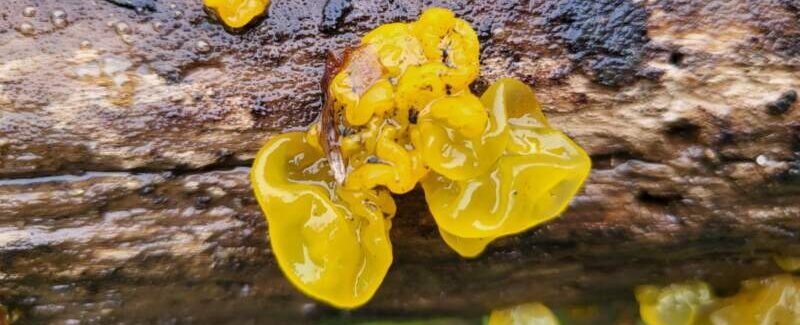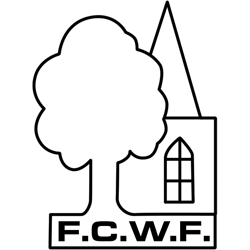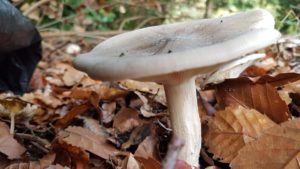The Seasons in Childwall Woods and Fields
The woods and fields are wonderful places to experience the unfolding of the seasons.
Each season brings its own beauty, sweeping across the site, changing every inch.
On this page, you will find photographs of Childwall Woods and Fields through the four seasons, from its wakening in spring, through its glory days of sunshine and plenty, during summer, into the quietly colourful days of autumn then back to sleep through the cold of winter. Everchanging. Always beautiful.
Let’s begin with ……..
Spring
FEBRUARY

Snowdrops are the first signs that spring isn’t far away. They peep out in February, which is really still winter hanging on by its frosty fingertips before the weather starts to warm up.
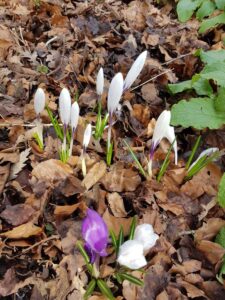
Beautiful bunches of crocus brighten the walks through the woods soon after the snowdrops.
A time for blossom. Next to the path on the top field, this tree is always first to bloom.
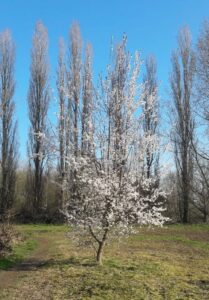
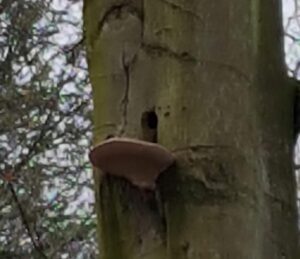 The trees with fungal mycelium in their heartwood, such as this old beech tree, display some wonderful brackets as the weather slowly warms.
The trees with fungal mycelium in their heartwood, such as this old beech tree, display some wonderful brackets as the weather slowly warms.
February is also the best time to hear Woodpeckers. Often heard but rarely seen.
MARCH
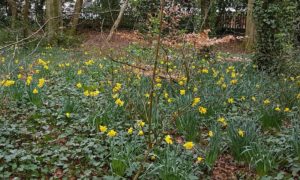
Daffodils near Childwall Abbey Road
Daffodils appear in March.
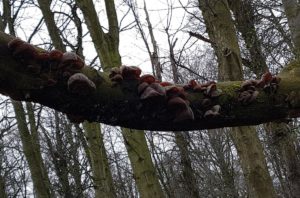
A Jelly fungus in March
But not everything that pops up in spring is beautiful.
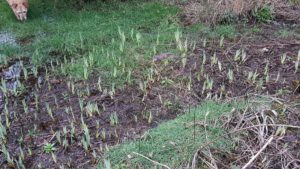
Iris’s just pushing through on the top field
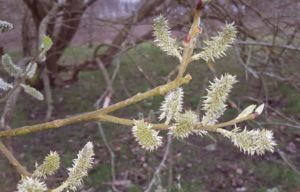
Buds on trees
There’s new life everywhere this month. These Irises are pushing up in the soft marshy patch near to the edge of the top field. Later in the year, these put on a beautiful show.
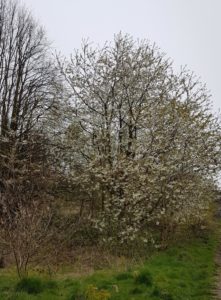
Creamy white blossoms
Colourful blossom bursts out on Hawthorn and many other bushes. Colours are still mainly whites and yellows at this time.
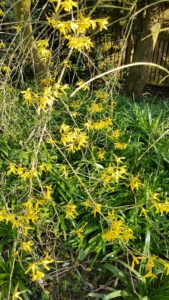
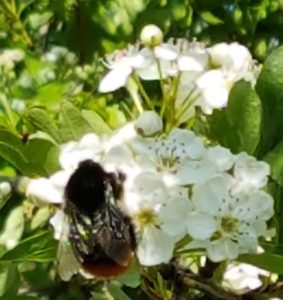
The blossom is a lifesaver for newly emerged Queen Bees before there are any other flowers.
APRIL
April is the time of the bluebells and what a show they put on, taking advantage of the spring sunshine before the new leaves shade the woodland again.
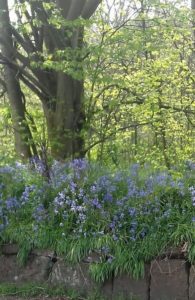
Bluebells on Childwall Lane – D. Jones
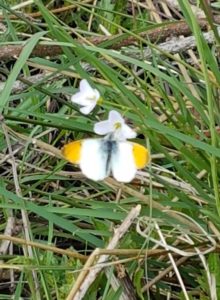
April is the month that the orange tip butterflies appear. Just the males, the less colourful females wait for warmer weather.
They are mostly seen on the top field especially around the edges of the woods on the hawthorn blossom and on the wildflowers that we planted earlier in the year.
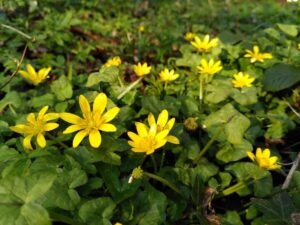
Celandine’s – 2/4/ 2022 – Matt Jones
Celandines, one of our many wildflowers catches the eye as you walk on the fields this month
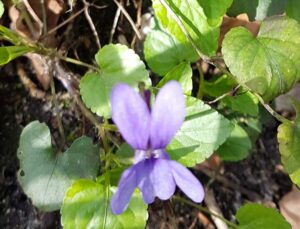
Early Dog-Violet 2/4/20
The tiny blue Early Dog-Violet ( Viola reichenbachiana ) hides in the woods but can be found in April.
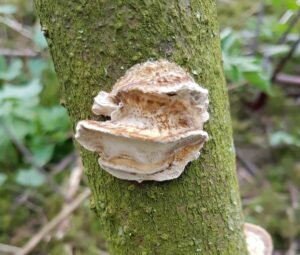
Dryads Saddle – top field – 3/4/20
The warmer weather brings out some very strange fruiting bodies on old wet trees. This wood rot mushroom is edible if you dare.
MAY
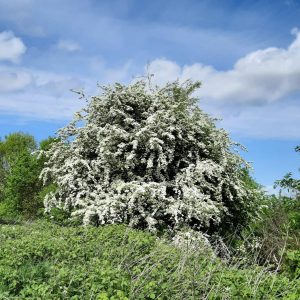
Hawthorn Blossom- David Holland
May is the month when the grasses grow tall on the fields and the tree pollen gives way to the grass pollen.
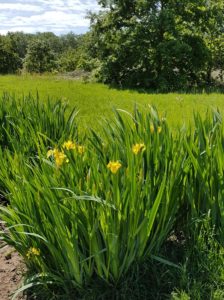
The Iris’s show off their beautiful yellow flowers now even though their pond has dried up in the afternoon sun. The fields become green and teeming with specks of wildflowers.
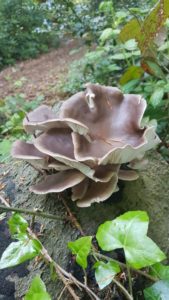
The warmth of early May on the damp dead tree trunk is perfect for this beautiful fungi to bloom. Breaking down the deadwood and returning it to the soil.
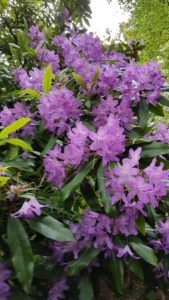
Rhododendrons in full bloom on the path
Rhododendrons, survivors from the grounds of Childwall Hall, begin to open in the spring sunshine, promising another spectacular show in the woods later on.
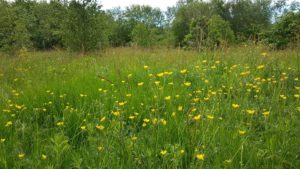
Buttercups sweep across the top field.
The woods are truly awake by the end of May.
And the fields put on a beautiful show of Buttercups.
Summer
JUNE
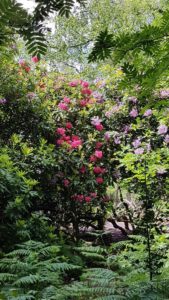
A red Rhododendron stands out in the woods
The Rhododendrons dominate the woods with their pinks and lilacs. It is said that they were once in lines, planted in the grounds for the pleasure of the residents of the Hall. Now they have lost their shape and grow to please themselves…. and us at this time of year.
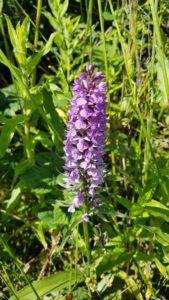
A Marsh Orchid
June is the time of the 5ft high grass on the fields and the long-awaited Marsh Orchids.
Marsh Orchids are all over the damper areas of the top field. Shortlived but stunning.
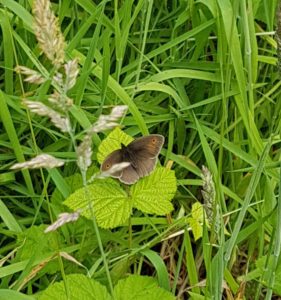
A meadow Brown Butterfly
The fields are full of butterflies hidden unless you disturb them. Meadow Brown butterflies dominate the grassy areas but the Small Whites take over the brambles tristing up in knots when accidentally meeting.
JULY
The ragwort is showing in July. Bright and beautiful. Toxic to humans but everything else seems to love it.
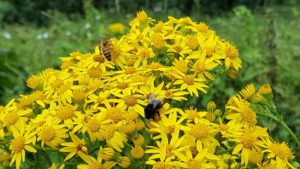
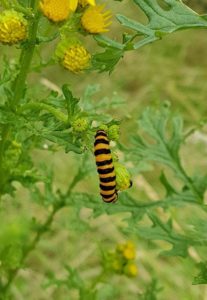
The Cinnabar Moth Caterpillars feast on the ragwort too. This brightly marked caterpillar is safe as its marking warn predators that it is not good to eat. It turns into a red and black moth which is equally safe from predators.
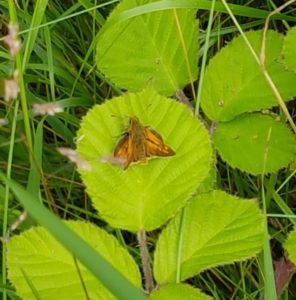
There are all kinds of butterflies on the fields at this time of year. This is a Large Skipper hiding in the grass but Small Skippers are everywhere if you are quick enough to catch sight of them.
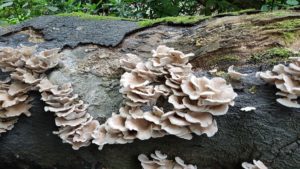
Oyster mushrooms
The warmth of July along with a rainy spell produced some wonderful fungus in the woods. Oyster Mushrooms love an old Beech log. This crop didn’t go to waste, they were delicious.
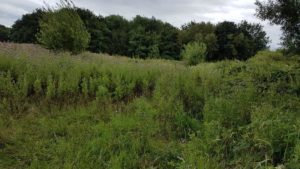
The middle field
The middle and lower fields are almost impenetrable but full of life if you care to stop and look
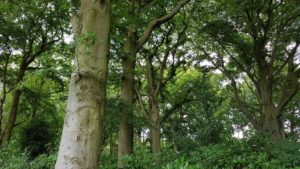
The Woods in full leaf
The woods are at their most beautiful now and full of birds and squirrels enjoying the fruits of summer. No photograph can show the sounds and fragrances that are filling the woods at this time of year.
August
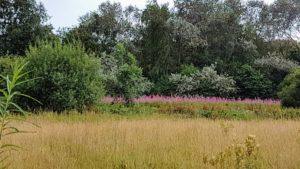
The Rosebay Willow Herb is in bloom on the top field now drawing its purple line between the grass and the trees.
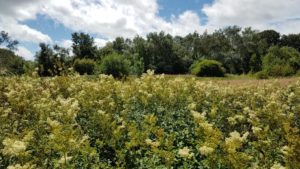
The Top Field
The fields are full of wildflowers, grasses, butterflies and bees.
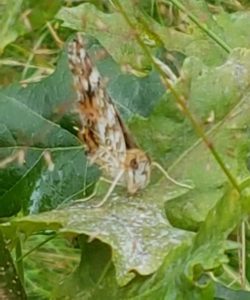
On a rainy day, the butterflies rest. This Painted Lady Butterfly is sitting on an oak leaf waiting for the sun, her face clearly showing how she got her name.
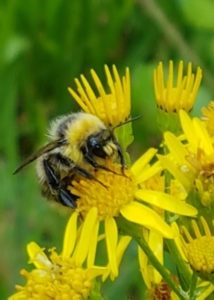
Everything is eating voraciously while it is on offer and there is a lot on offer if you are a bee.
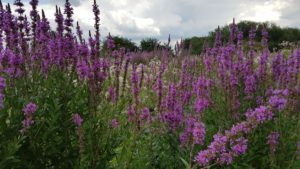
A breathtaking display on the middle field in August.
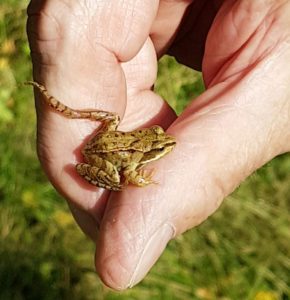
Typical British weather for this month is the downpour and the creatures of the woods and fields love it. Especially this little guy and his family.
The Common Frog is the only species of frog found in the UK. We do have 2 species of toad in Britain and you can see the Common Toad on the Childwall site if you happen to disturb one.
AUTUMN
September
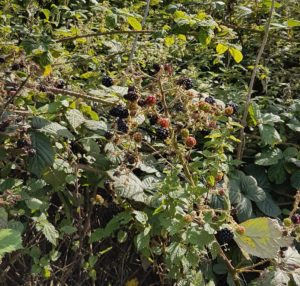
The month of mellow fruitfulness so it’s said, and that is certainly true in Childwall Woods and Fields. The blackberries are heavy on the bushes, a feast for the birds as well as the walkers.
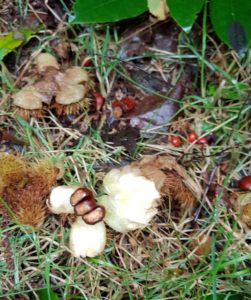
The sweet chestnuts that have been wrapped in their spikey bundles are now opening up to reveal shiny treats inside.
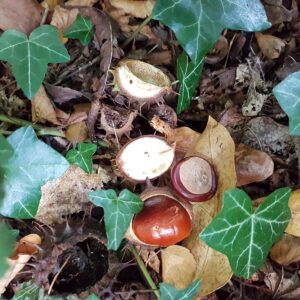
Conkers drop like bombs down the carriageway.
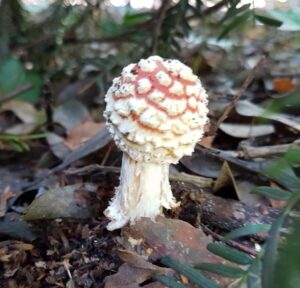
A young Fly Agaric.
And fungus of all kinds adds colour to the leaf litter.
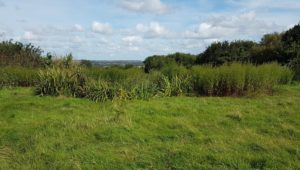
The view from the top field is just as stunning as it was in the other seasons but now the grass has lost its height and the Irises have finished blooming.
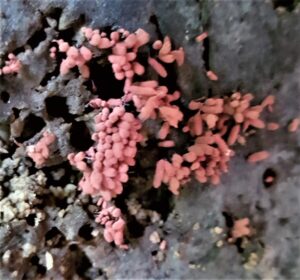
This is a Carnival Candy Slime Mould. You can read more about how it grows, on the Slime Mould page.
Slime moulds love the cooler wetter days and find a foothold on already rotting wood.
Even rotting tree stumps look good. Everywhere you look there are acorns, fungi and beechnuts. It’s a beautiful magical place.
October
There’s no doubt that nature is drawing back for the winter. The woods are changing their colours from greens to rusty browns but are still as beautiful as they were in the middle of summer.
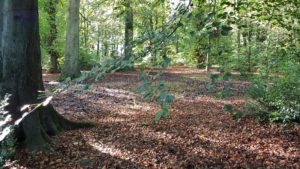
The woodland floor is covered with beechnuts now and on a dry day, the leaves crunch beneath your feet. One of the pleasures of autumn.
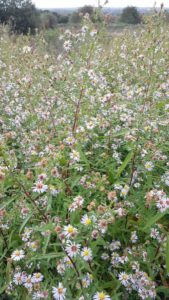
On the top field, the Michaelmas Daisies show off with no competition as all the other flowers have turned to seeds and berries now.
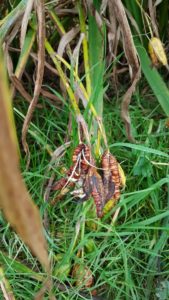
The irises, so beautiful in Summer are now heavy with seeds ready to sow next year’s display.
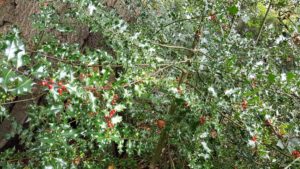
The Holly berries shine out a bright red, calling to the birds to come and eat them and that way spread their seeds throughout the woods. How Christmassy the woods look now the Holly berries are here.
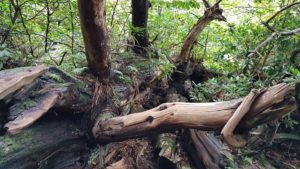
The bird song is less noticeable now as their habitat changes and the cold weather begins to bite. Some have flown but not the robin that is always around in the woods.
Bats too will become more scarce as they tuck up in roosts for the winter, having mated earlier in the month. Old hollow trees like this one with plenty of south-facing hollows make warm winter homes for hibernating bats.
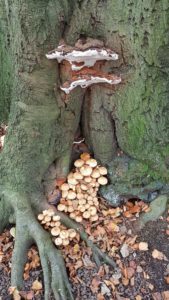
Fungi are everywhere in the woods this month and the trees seem to embrace them.
Some are in large clumps
But some are just LARGE.
October is the perfect month for mushroom foraging IF you know what you are doing and use caution.
We want you to be around to see the next month in Childwall Woods and Fields
November
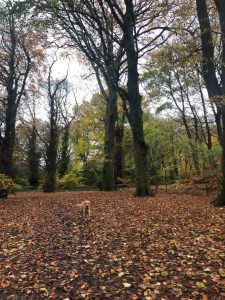
Dudley enjoying the walk. By kind permission of Patrick Gaul
The month when the colour of the wood turns from green to brown.
Still leafy at the start of November but the leaves falling fast now.
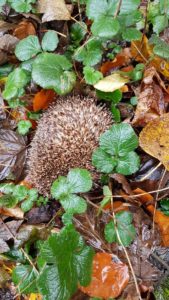
Still a few hedgehogs around but very sleepy and ready for hibernation.
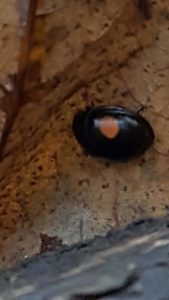
Some of the many ladybirds that live in the woods can be seen getting ready to tuck themselves away in the hedges. This black one is a Kidney-spot Ladybird with just 1 red kidney shaped spots on each wing and is known to favour deciduous trees. One of our native species.
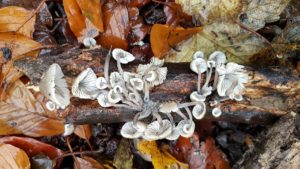
Fallen branches are perfect places for beautiful fungal arrangements. This one proudly displays the underside of tiny delicate bonnets.
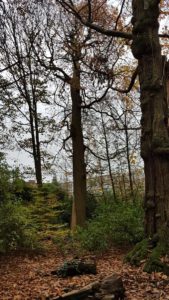
Late November and the woods are almost bare. The creatures that live here, hidden away ready for colder weather.
WINTER
December
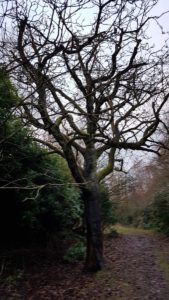
The bare winter woods seem dead at this time of year but that is not the case. There is life everywhere. You just have to look.
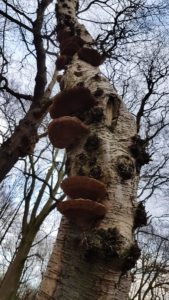
Blushing Brackets on an old Birch tree.
Fungus is bursting out everywhere.
The old trees that are dead provide nutrients for the fruiting bodies of the mycelium which will eventually return those nutrients to the soil.
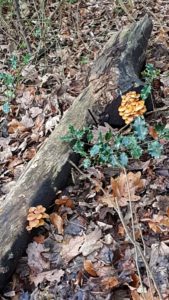
Clumps of mushrooms (some call them toadstools) burst out in unlikely places.
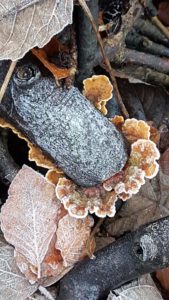
Hairy Curtain Crust. It’s everywhere in the woods during the winter months.
This Hairy Curtain Crust is a pleasant reminder that not everything is dead or dormant.
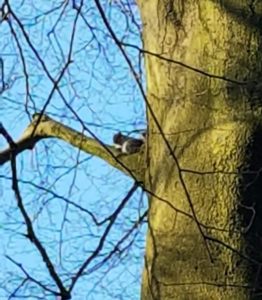
If you look up on a sunny December afternoon you may see a grey squirrel warming up in the winter sun. Even squirrels get insomnia when it’s sunny and they’ve got a nut or two hidden away.
For now, the woods are dormant and keeping their residents safe and warm until its time to come out again.
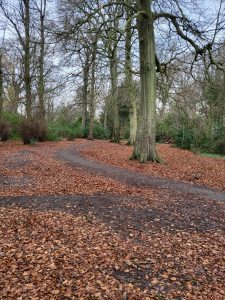 But that’s months away. Winter has only just begun.
But that’s months away. Winter has only just begun.
January
January brings the promise of a new year, new growth, and new beginnings in the Woods and Fields.
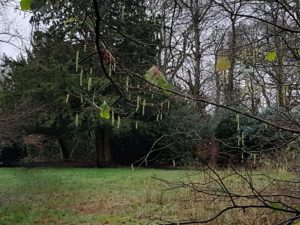
Catkins announce that the sap is rising and the trees are beginning to wake up.
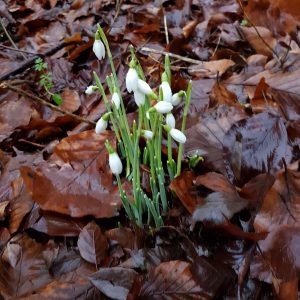
B Cameron Jan 21
Shoots appear around the woods making the most of the sunlight coming through before the leaves of the mantle appear and the shade returns.
The white flowers first. Snowdrops.
The vegetation in the Fields is still low and flat. The high grasses and remains of the summer flowers are covering any signs of new shoots in January.
The winter wind keeps these exposed places cold and inhospitable most of this month with just a glimmer of watery sunshine trying to bring the wildflowers back to life.

Although winter still has a grip on the site of Childwall Woods and Fields it can’t take away the beauty that is everywhere and in every season.
Author: B Cameron
Photographs are the author’s own unless indicated otherwise
